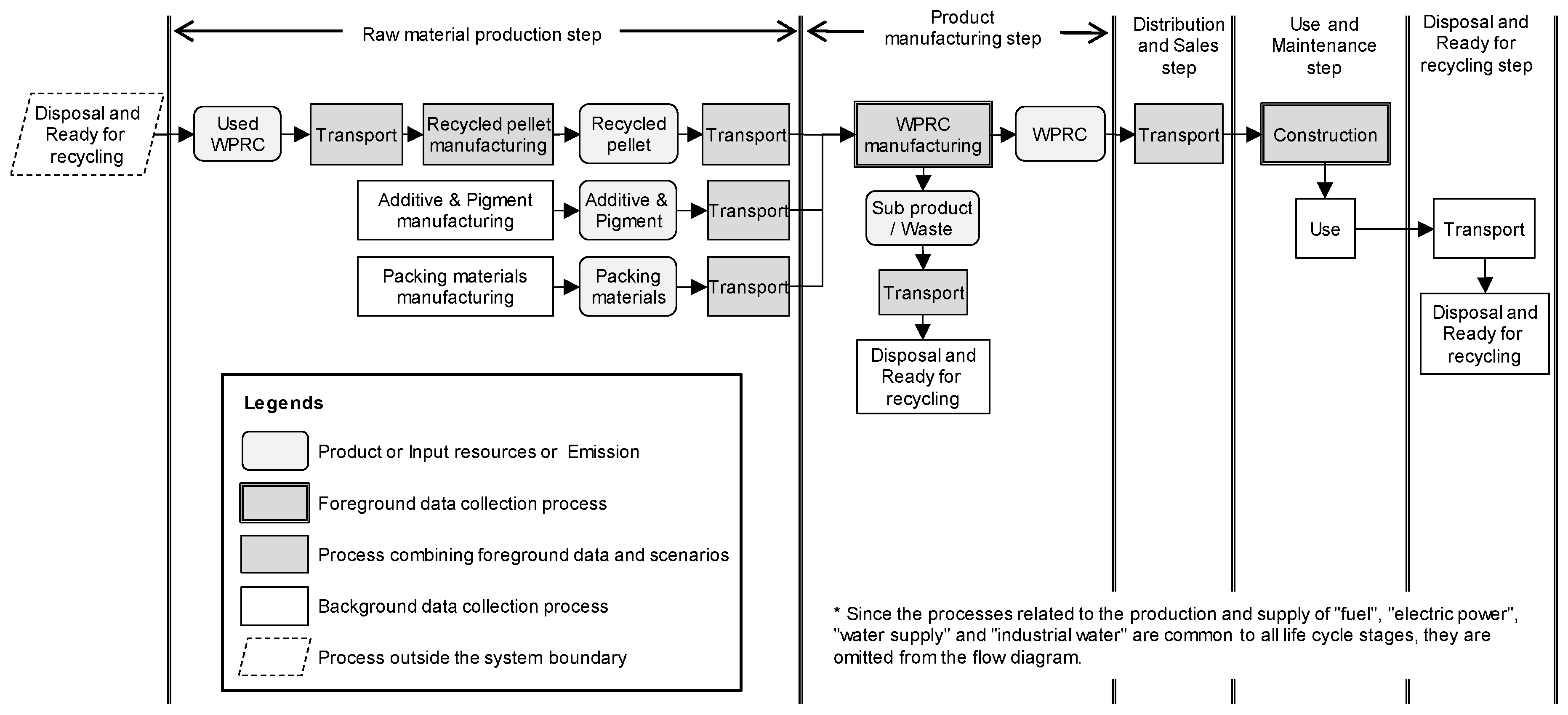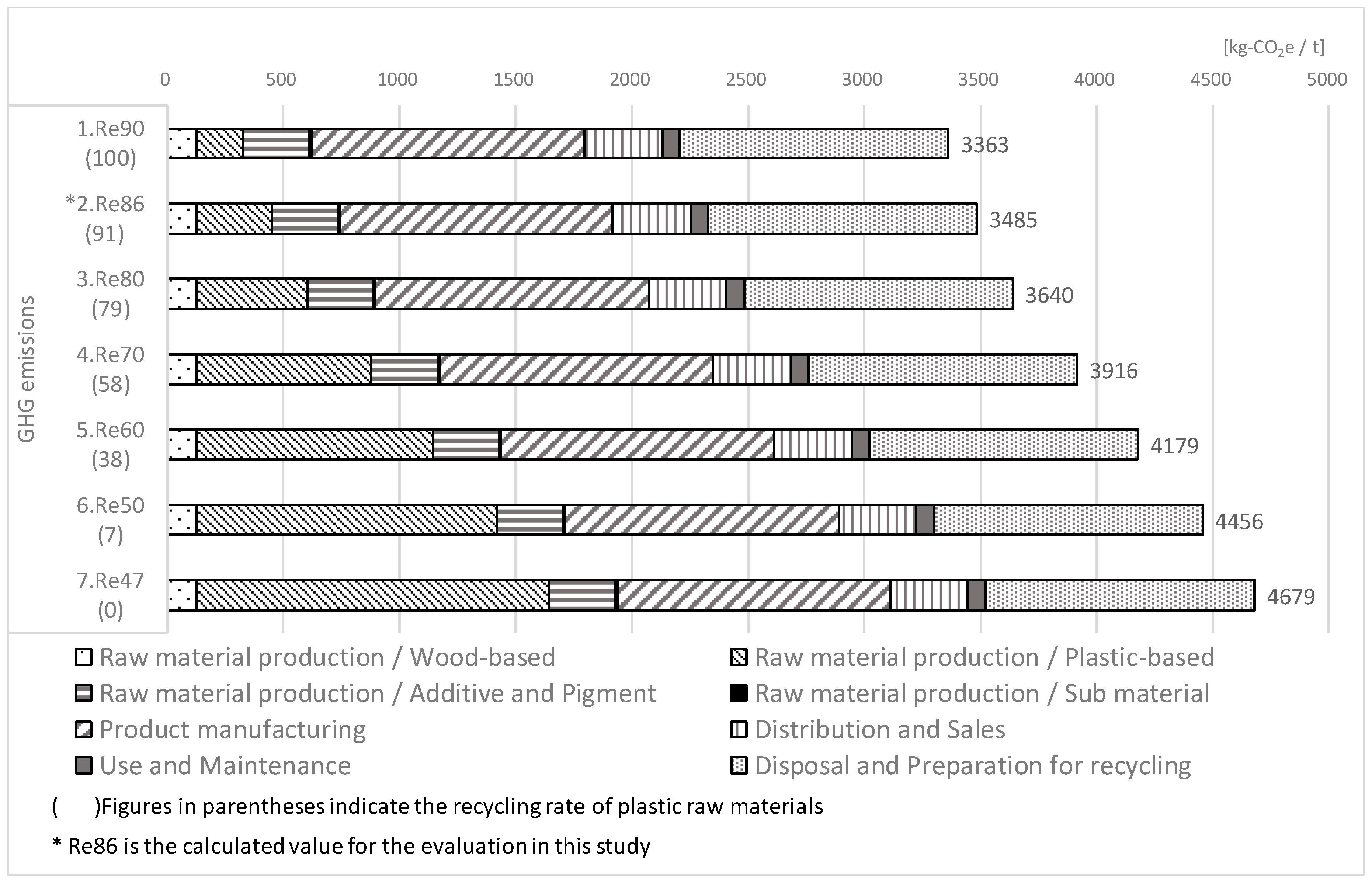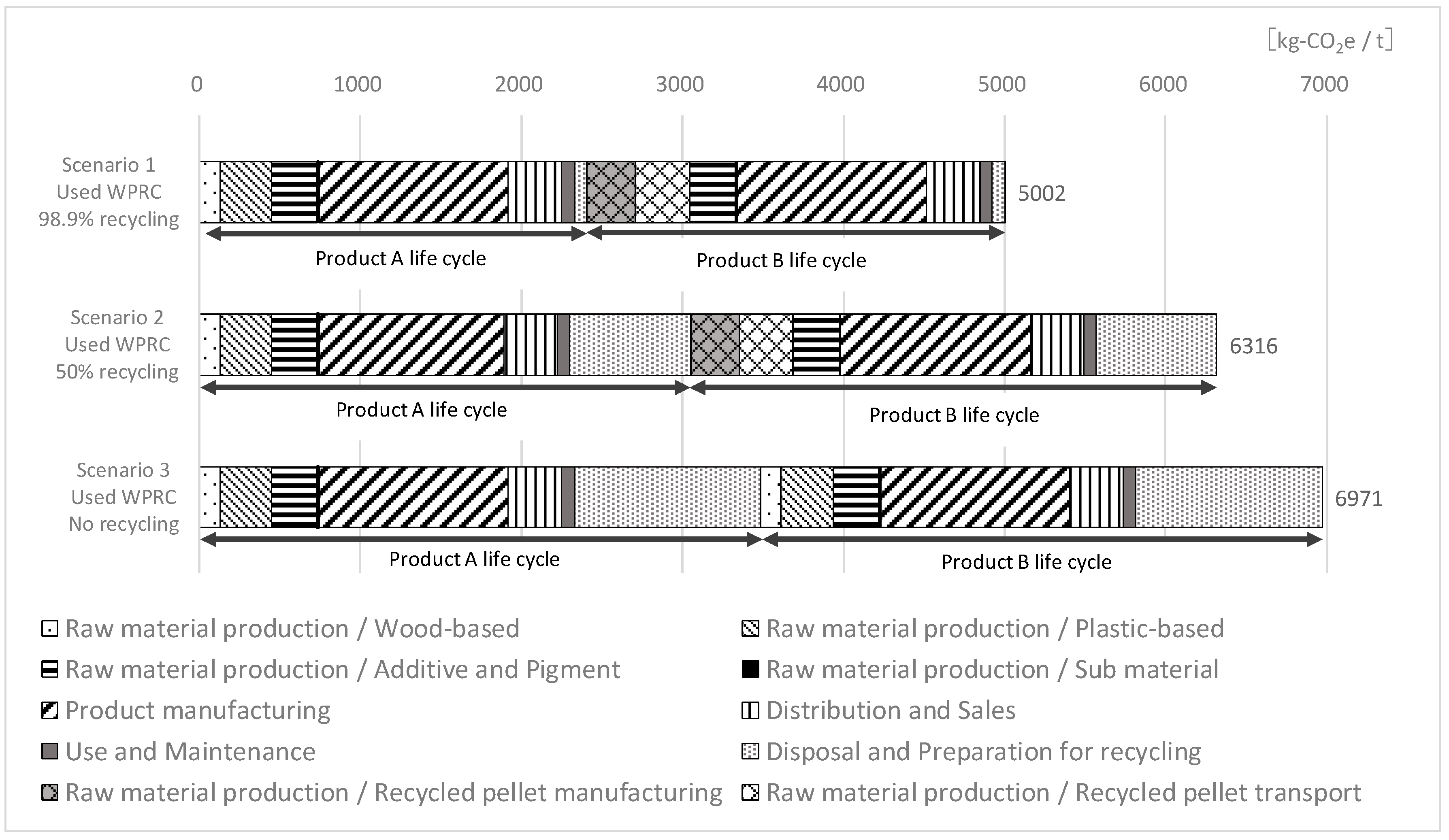Quantification of Greenhouse Gas Emissions from Wood-Plastic Recycled Composite (WPRC) and Verification of the Effect of Reducing Emissions through Multiple Recycling
Abstract
1. Background and Purpose
2. Evaluation Target and Methods
2.1. Evaluation of GHG Emissions from the Life Cycle per Ton of WPRC Products
2.2. Evaluation of GHG Emissions When the Recycling Rate of Plastic-Based Raw Materials Is Changed
2.3. GHG Emission Reduction Effect by Multiple Recycling of Used WPRC
3. Results and Discussion
3.1. Life Cycle Inventory per Ton of WPRC Product
3.1.1. Raw Material Production Step
3.1.2. Product Manufacturing Step
3.1.3. Distribution and Sales Step
3.1.4. Use and Maintenance Step
3.1.5. Disposal and Ready for Recycling Step
3.2. GHG Emissions from the Life Cycle per Ton of WPRC Products
3.3. GHG Emissions When the Recycling Rate of Plastic-Based Raw Materials Is Changed
3.4. GHG Emission Reduction Effect by Multiple Recycling of Used WPRC
3.4.1. Life Cycle Inventory per Ton of WPRC Products
3.4.2. GHG Emission Reduction Effect by Multiple Recycling
4. Conclusions
- The GHG emission during the life cycle of the targeted WPRC materials was 3489 kg-CO2e/t, and the ratio of the emission from the product manufacturing process in the product manufacturing step and the combustion of waste process in the disposal and ready for recycling step was found to be particularly high.
- For the raw materials used in the preparation of WPRC, GHG emissions were calculated assuming that the recycling rate of wood-based materials was 100%, but the recycling rate of plastic-based materials fluctuated between 0% and 100%. It was found that setting the recycled material rate of plastic materials to 100% would reduce GHG emissions by 28% (1316 kg-CO2e/t) compared to when the recycled material rate was 0%.
- We found that GHG emissions can be reduced by up to approximately 28% through multiple recycling of WPRC. In the multiple recycling cases, GHG emissions from the disposal of used WPRC could be significantly reduced, while emissions from the transportation process of the used WPRC were relatively large.
Author Contributions
Funding
Acknowledgments
Conflicts of Interest
References
- Architectural Institute of Japan. Building LCA Guidelines Revised Edition; Maruzen Publishing: Tokyo, Japan, 2013. [Google Scholar]
- Saldaña-Márquez, H.; Gómez-Soberón, J.M.; Arredondo-Rea, S.P.; Gámez-García, D.C.; Corral-Higuera, R. Sustainable social housing: The comparison of the Mexican funding program for housing solutions and building sustainability rating systems. Build. Environ. 2018, 133, 103–122. [Google Scholar]
- Saldaña-Márquez, H.; Gámez-García, D.C.; Gómez-Soberón, J.M.; Arredondo-Rea, S.P.; Corral-Higuera, R.; Gómez-Soberón, M.C. Housing indicators for sustainable cities in middle-income countries through the residential urban environment recognized using single-family housing rating systems. Sustainability 2019, 11, 4276. [Google Scholar] [CrossRef]
- Kobayashi, K.; Isobe, T. LCA utilizatopm for buildings: Current situation and future issues. AIJ J. Technol. Des. 2018, 24, 1129–1134. [Google Scholar]
- Ramesh, T.; Prakash, R.; Shukla, K.K. Life cycle energy analysis of buildings: An overview. Energy Build. 2010, 42, 1592–1600. [Google Scholar] [CrossRef]
- Cabeza, L.F.; Rincón, L.; Vilariño, V.; Pérez, G.; Castell, A. Life cycle assessment (LCA) and life cycle energy analysis (LCEA) of buildings and the building sector: A review. Renew. Sustain. Energy Rev. 2014, 29, 394–416. [Google Scholar] [CrossRef]
- Gámez-García, D.C.; Saldaña-Márquez, H.; Gómez-Soberón, J.M.; Arredondo-Rea, S.P.; Gómez-Soberón, M.C.; Corral-Higuera, R. Environmental challenges in the residential sector: Life cycle assessment of Mexican social housing. Energies 2019, 12, 2837. [Google Scholar] [CrossRef]
- Gámez-García, D.C.; Gómez-Soberón, J.M.; Corral-Higuera, R.; Saldaña-Márquez, H.; Gómez-Soberón, M.C.; Arredondo-Rea, S.P. A cradle to handover life cycle assessment of external walls: Choice of materials and prognosis of elements. Sustainability 2018, 10, 2748. [Google Scholar] [CrossRef]
- Tonooka, Y. Housing LCA and environmental load data base. J. Life Cycle Assess. Jpn. 2017, 13, 126–133. [Google Scholar] [CrossRef]
- Liu, Y.; Guo, H.; Sun, C.; Chang, W. Assessing cross laminated timber (CLT) as an alternative material for mid-rise residential buildings in cold regions in China-A life-cycle assessment approach. Sustainability 2016, 8, 1047. [Google Scholar] [CrossRef]
- Tettey, U.; Dodoo, A.; Gustavsson, L. Effect of different frame materials on the primary energy use of a multi storey residential building in a life cycle perspective. Energy Build. 2019, 185, 259–271. [Google Scholar] [CrossRef]
- Morea, D.; Antonio, L. Islamic finance and renewable energy: An innovative model for the sustainability of investments. In Proceedings of the 2016 AEIT International Annual Conference, Capri, Italy, 5–7 October 2016. [Google Scholar]
- Morea, D.; Antonio, L. An innovative model for the sustainability of investments in the wind energy sector: The use of green Sukuk in an Italian case study. Int. J. Energy Econ. Policy 2017, 7, 53–60. [Google Scholar]
- Campisi, D.; Gitto, S.; Morea, D. Shari’ah-compliant finance: A possible novel paradigm for green economy investments in Italy. Sustainability 2018, 10, 3915. [Google Scholar] [CrossRef]
- Martínez-Rocamora, A.; Solís-Guzmán, J.; Marrero, M. LCA databases focused on construction materials: A review. Renew. Sustain. Energy Rev. 2016, 58, 565–573. [Google Scholar] [CrossRef]
- Kiguchi, M.; Kobayashi, M. Performance and technical trends of wood plastic composites (WPCs). Wood Ind. 2012, 67, 50–55. [Google Scholar]
- Gardner, D.J.; Han, Y.; Wang, L. Wood-plastic composite technology. Curr. For. Rep. 2015, 1, 139–150. [Google Scholar] [CrossRef]
- Kojiro, K. Eco-friendly wood and plastic recycled composite (WPRC). Sol. Energy 2014, 40, 7–13. [Google Scholar]
- Japanese Standards Association. JIS A 5741, Wood-Plastic Recycled Composite; Japanese Standards Association: Tokyo, Japan, 2016; pp. 1–21. [Google Scholar]
- Bolin, C.A.; Smith, S. Life cycle assessment of ACQ-treated lumber with comparison to wood plastic composite decking. J. Clean. Prod. 2011, 19, 620–629. [Google Scholar] [CrossRef]
- Philipp, F.S.; Jan, L.W.; Sebastian, R.; Andreas, K. Life cycle assessment of wood-plastic composites: Analysing alternative materials and identifying an environmental sound end-of-life option. Resour. Conserv. Recycl. 2017, 117, 235–248. [Google Scholar]
- Fuchigami, Y.; Kojiro, K.; Furuta, Y. Life cycle CO2 of wood plastic recycled composites. J. Environ. Eng. Trans. AIJ 2011, 76, 83–89. [Google Scholar] [CrossRef][Green Version]
- Wada, Y.; Miura, H.; Hirata, A. Study on evaluation method of environmental impact on the phase of recycle for life cycle assessment. Environ. Syst. Res. 1994, 22, 141–146. [Google Scholar] [CrossRef]
- Carbon Footprint Communication Program. Certified CFP-PCR Number: PA-CB-01, Wood-Plastic Composites; Carbon Footprint Communication Program: Tokyo, Japan, 2011; pp. 1–16. [Google Scholar]
- General Waste Discharge and Treatment Status, etc. Available online: https://www.env.go.jp/press/files/jp/105331.pdf (accessed on 18 November 2019).
- IDEA LCA Database. Available online: http://www.idea-lca.jp/ (accessed on 10 February 2020).





| Step | Process | Specific Process | Unit | Quantity | Corresponding Figure 1 Process | |
|---|---|---|---|---|---|---|
| Raw material production | Wood-based raw material production | Production | Wood chip | m3 | 8.78 × 10−1 | d) |
| Transport (outward) | Truck (10 t, loading rate 50%) | tkm | 2.17 × 102 | a), e) | ||
| Transport (homeward) | Truck (10 t, no loading) | km | 4.31 × 101 | a), e) | ||
| Transport (outward) | Truck (2 t, loading rate 50%) | tkm | 2.51 × 100 | a), e) | ||
| Transport (homeward) | Truck (2 t, no loading) | km | 2.51 × 100 | a), e) | ||
| Mixed pellet production | Electricity | kWh | 6.34 × 101 | h) | ||
| Mixed pellet production | Light oil | L | 3.64 × 10−2 | h) | ||
| Mixed pellet production | Kerosene | L | 1.86 × 10−1 | h) | ||
| Mixed pellet production | Waterworks | m3 | 6.32 × 10−2 | h) | ||
| Mixed pellet transport (outward) | Truck (10 t, loading rate 50%) | tkm | 4.37 × 100 | i) | ||
| Mixed pellet transport (homeward) | Truck (10 t, no loading) | km | 8.74 × 10−1 | i) | ||
| Plastic-based raw material production | Production | Virgin plastic | kg | 4.14 × 101 | b), f), j) | |
| Production | Recycled plastic | kg | 4.05 × 102 | b), f), j) | ||
| Transport (outward) | Truck (10 t, loading rate 50%) | tkm | 1.21 × 102 | c), g), k) | ||
| Transport (homeward) | Truck (10 t, no loading) | km | 2.43 × 101 | c), g), k) | ||
| Transport (outward) | Railway | tkm | 2.36 × 101 | c) | ||
| Pigments and Additives production | Production | Computerizing agent | kg | 8.74 × 100 | l) | |
| Production | Skid (Part 1) | kg | 5.73 × 100 | l) | ||
| Production | Skid (Part 1) | kg | 4.47 × 101 | l) | ||
| Production | Pigment | kg | 3.04 × 101 | l) | ||
| Production | Stabilizer | kg | 1.23 × 101 | l) | ||
| Production | Antioxidant | kg | 1.30 × 100 | l) | ||
| Transport (outward) | Truck (10 t, loading rate 50%) | tkm | 6.20 × 101 | m) | ||
| Transport (homeward) | Truck (10 t, no loading) | km | 1.24 × 101 | m) | ||
| Sub material production | Production | Cardboard sheet | m2 | 9.79 × 100 | n) | |
| Production | Stretch film | kg | 2.02 × 10−1 | n) | ||
| Production | Banding band | kg | 1.10 × 10−1 | n) | ||
| Production | Air cap | kg | 2.77 × 10−1 | n) | ||
| Production | Wood pallet | m3 | 1.56 × 10−2 | n) | ||
| Transport (outward) | Truck (10 t, loading rate 50%) | tkm | 5.74 × 10−1 | o) | ||
| Transport (homeward) | Truck (10 t, no loading) | km | 1.15 × 10−1 | o) | ||
| Product production | WPRC production | Production | Electricity | kWh | 1.99 × 103 | p) |
| Production | Waterworks | m3 | 8.33 × 10−1 | p) | ||
| Production | Industrial water | m3 | 3.18 × 100 | p) | ||
| Production | Light oil | L | 8.20 × 10−1 | p) | ||
| Production | Gasoline | L | 2.27 × 10−1 | p) | ||
| Production | Kerosene | L | 6.36 × 10−1 | p) | ||
| Production | Gas | kg | 2.83 × 10−3 | p) | ||
| Production | Bunker A | L | 4.95 × 100 | p) | ||
| Disposal and Ready for recycling | Transport (outward) | Truck (2 t, loading rate 25%) | tkm | 2.96 × 100 | q) | |
| Transport (homeward) | Truck (2 t, no loading) | km | 5.92 × 100 | q) | ||
| Waste disposal (Defective) | Incineration | kg | 1.14 × 101 | r) | ||
| Waste disposal (Defective) | Landfill | kg | 1.60 × 10−1 | r) | ||
| Waste disposal (Defective) | Ready for recycling | kg | 2.96 × 100 | r) | ||
| Waste disposal (Plastic) | Incineration | kg | 2.15 × 100 | r) | ||
| Waste disposal (Plastic) | Landfill | kg | 3.01 × 10−2 | r) | ||
| Waste disposal (Plastic) | Ready for recycling | kg | 5.58 × 10−1 | r) | ||
| Waste disposal (Wood scrap) | Incineration | kg | 1.24 × 101 | r) | ||
| Distribution and Sales | Distribution | Transport (outward) | Truck (10 t, loading rate 50%) | tkm | 1.00 × 103 | s) |
| Transport (homeward) | Truck (10 t, no loading) | km | 2.00 × 102 | s) | ||
| Use and Maintenance | Use | Construction | electricity | kWh | 1.49 × 102 | t) |
| Disposal and Ready for recycling | Disposal andReady for recycling | Transport (outward) | Truck (2 t, loading rate 50%) | tkm | 5.00 × 101 | v) |
| Transport (homeward) | Truck (2 t, no loading) | km | 5.00 × 101 | v) | ||
| Waste disposal | Incineration | kg | 7.85 × 102 | w) | ||
| Waste disposal | Combustion of plastic and pigments/additives | kg | 4.20 × 102 | w) | ||
| Waste disposal | Landfill | kg | 1.10 × 101 | w) | ||
| Waste disposal | Ready for recycling | kg | 2.04 × 102 | w) | ||
| Step | Process | GHG Emissions (kg-CO2e/t) | Emission Rate (%) | |
|---|---|---|---|---|
| Raw material production | Wood-based raw material | Production | 5.34 × 101 | 1.5% |
| Transport | 7.61 × 101 | 2.2% | ||
| Plastic-based raw material | Production | 2.80 × 102 | 8.0% | |
| Transport | 3.97 × 101 | 1.1% | ||
| Pigments and Additives | Production | 2.64 × 102 | 7.6% | |
| Transport | 2.07 × 101 | 0.6% | ||
| Sub material | 9.87 × 100 | 0.3% | ||
| Product manufacturing | WPRC production | 1.15 × 103 | 32.9% | |
| Waste disposal | 2.69 × 101 | 0.8% | ||
| Distribution and Sales | Distribution | 3.34 × 102 | 9.6% | |
| Use and Maintenance | Construction | 7.63 × 101 | 2.2% | |
| Disposal and Ready for recycling | Transport | 4.77 × 101 | 1.4% | |
| Waste disposal | 3.65 × 101 | 1.0% | ||
| Waste combustion | 1.07 × 103 | 30.8% | ||
| Total | 3.49 × 103 | 100% | ||
| Pattern | Recycling Rate of Plastic-Based Raw Materials (%) | Recycling Rate of the Entire Product (%) |
|---|---|---|
| 1 | 100 | 90 |
| 2 | 91 | 86 |
| 3 | 77 | 80 |
| 4 | 53 | 70 |
| 5 | 30 | 60 |
| 6 | 7 | 50 |
| 7 | 0 | 47 |
| Step | Process | Specific Process | Unit | Quantity | ||
|---|---|---|---|---|---|---|
| Senario1 | Senario2 | |||||
| Raw material production | Recycled Pellet production | Transport (outward) | Truck (10 t, loading rate 50%) | tkm | 5.00 × 102 | |
| Transport (homeward) | Truck (10 t, no loading) | km | 1.00 × 102 | |||
| Production | Recycled Pellet | t | 1.00 × 100 | |||
| Transport (outward) | Truck (10 t, loading rate 50%) | tkm | 5.00 × 102 | |||
| Transport (homeward) | Truck (10 t, no loading) | km | 1.00 × 102 | |||
| Pigments and Additives production | Production | Compatibilizing agent | kg | 8.74 × 100 | ||
| Production | Skid (Part 1) | kg | 5.73 × 100 | |||
| Production | Skid (Part 1) | kg | 4.47 × 101 | |||
| Production | Pigment | kg | 3.04 × 101 | |||
| Production | Stabilizer | kg | 1.23 × 101 | |||
| Production | Antioxidant | kg | 1.30 × 100 | |||
| Transport (outward) | Truck (10 t, loading rate 50%) | tkm | 6.20 × 101 | |||
| Transport (homeward) | Truck (10 t, no loading) | km | 1.24 × 101 | |||
| Sub material production | Production | Cardboard sheet | m2 | 9.79 × 100 | ||
| Production | Stretch film | kg | 2.02 × 10−1 | |||
| Production | Banding band | kg | 1.10 × 10−1 | |||
| Production | Air cap | kg | 2.77 × 10−1 | |||
| Production | Wood pallet | m3 | 1.56 × 10−2 | |||
| Transport (outward) | Truck (10 t, loading rate 50%) | tkm | 5.74 × 10−1 | |||
| Transport (homeward) | Truck (10 t, no loading) | km | 1.15 × 10−1 | |||
| Disposal and Ready for recycling | Disposal and Ready for recycling | Transport (outward) | Truck (2 t, loading rate 50%) | tkm | 5.00 × 101 | |
| Transport (homeward) | Truck (2 t, no loading) | km | 5.00 × 101 | |||
| Waste disposal | Incineration | kg | 0.00 × 100 | 4.88 × 102 | ||
| Waste disposal | Combustion of plastic and pigments/additives | kg | 0.00 × 100 | 2.61 × 102 | ||
| Waste disposal | Landfill | kg | 1.10 × 101 | 1.10 × 101 | ||
| Waste disposal | Ready for recycling | kg | 9.91 × 102 | 5.01 × 102 | ||
© 2020 by the authors. Licensee MDPI, Basel, Switzerland. This article is an open access article distributed under the terms and conditions of the Creative Commons Attribution (CC BY) license (http://creativecommons.org/licenses/by/4.0/).
Share and Cite
Fuchigami, Y.; Kojiro, K.; Furuta, Y. Quantification of Greenhouse Gas Emissions from Wood-Plastic Recycled Composite (WPRC) and Verification of the Effect of Reducing Emissions through Multiple Recycling. Sustainability 2020, 12, 2449. https://doi.org/10.3390/su12062449
Fuchigami Y, Kojiro K, Furuta Y. Quantification of Greenhouse Gas Emissions from Wood-Plastic Recycled Composite (WPRC) and Verification of the Effect of Reducing Emissions through Multiple Recycling. Sustainability. 2020; 12(6):2449. https://doi.org/10.3390/su12062449
Chicago/Turabian StyleFuchigami, Yuki, Keisuke Kojiro, and Yuzo Furuta. 2020. "Quantification of Greenhouse Gas Emissions from Wood-Plastic Recycled Composite (WPRC) and Verification of the Effect of Reducing Emissions through Multiple Recycling" Sustainability 12, no. 6: 2449. https://doi.org/10.3390/su12062449
APA StyleFuchigami, Y., Kojiro, K., & Furuta, Y. (2020). Quantification of Greenhouse Gas Emissions from Wood-Plastic Recycled Composite (WPRC) and Verification of the Effect of Reducing Emissions through Multiple Recycling. Sustainability, 12(6), 2449. https://doi.org/10.3390/su12062449




